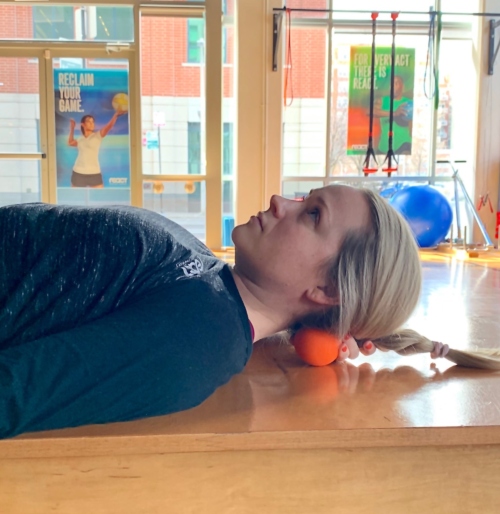Stress: Find Relief

Stress. We all experience it throughout our life at varying levels of severity, whether it be constant worry and stress over jobs, finances, a global pandemic, or personal struggles it is something we all have in common. The mind-body connection suggests how you think is how you feel, and how you feel can affect your thinking.
Stress can cause tense muscles, pain, headaches, and even individual compensatory postures or strategies which are indicative of our body’s natural protective reflex when vulnerable. Physical stressors (pain, injury, illness) can alternately affect your emotional state depending on your conscious awareness of this connection and how well you are able to cope with your illness at any given moment.
How many times have you heard someone say “I hold a lot of stress in my shoulders”, or “when I’m stressed my neck or back locks up”? Developing an understanding of your personal compensatory reactions to stress is the first step towards making a change for the better. When you begin to see the correlation between the mind-body, you can start to find ways to identify that link and create a shift in your perspective.
Think about this example… work deadlines fast approaching, stress, tense neck/shoulders, pain/headache, difficulty concentrating due to pain, mentally more difficult to meet work deadlines, compounded stress, on and on throughout the cycle.
If you are able to recognize from the beginning that your work deadlines lead to stress and subsequently a manifestation of your physical symptoms, you now have control over your physical symptoms because you know where to cut them off on their path to development.
When we are stressed, your body automatically shifts into “fight or flight” mode which is normal if you need to avoid danger. It releases hormones that increase your heart rate, increase your blood pressure, and tense your muscles. If you constantly feel stressed it can lead to a plethora of physical health problems, not to mention it can make you feel upset, tense, depressed, moody, angry, etc.
When we are able to relax our mind and body, your body stops producing these stress hormones and some of the physical symptoms of stress can decrease.
Let’s discuss ways to release some of the muscle tension for two common physical complaints that can be highly correlated with stress.
Headaches
Part 1: Headaches
*Note: there are many different types of headaches. If you have recurring or severe headaches, please contact your Primary Care Physician. If you have headaches with any of the following symptoms, please contact your nearest emergency care facility:
– Headaches that start early in the morning
– Pain that is worsened by strain, such as a cough or a sneeze
– Vomiting without nausea
– Sudden onset of pain and the “worst headache” ever
– Headache that is becoming more severe or continuous
– Personality changes
– Changes in vision
– Weakness in the arms or legs
– Seizures
– Facial paralysis: face/eye drooping
To help manage most headache types at home, try the following combination of a trigger point release, sustained pressure, and stretching to relieve tension, improve circulation, and stimulate endorphins.
- Suboccipital release with a lacrosse ball
- Scalene stretch with arm bind + open/close of jaw
- Masseter release
- Temporalis release/scrub
- Pressure point release: apply pressure to each for roughly 1 minute
- Space between eyebrows, where the bridge of the nose meets the forehead
- Inner corners of brow bones
- Center of both eyebrows
- Just below/to the sides of each nostril
![Untitled Design[2] Untitled Design[2]](https://bereact.com/wp-content/uploads/2020/04/Untitled-Design2-300x300.png)

Upper back/neck tension.
*Note: if you experience any numbness/tingling or loss of sensation during any of these, please stop and contact your Primary Care Physician if it persists. The normal strong aching sensation is normal, as long as it is a “good pain”.
- Pec release
- Functional pec stretch: 2 variations (wall and ground)
- Infraspinatus release
- Middle Trap/Rhomboids Release
- Modified side plank with lat rotation
- Seated lat stretch
- Prone diaphragmatic breathing
![Untitled Design[4] Untitled Design[4]](https://bereact.com/wp-content/uploads/2020/04/Untitled-Design4-300x300.png)
![Untitled Design[5] Untitled Design[5]](https://bereact.com/wp-content/uploads/2020/04/Untitled-Design5-300x300.png)

![Untitled Design[2] Untitled Design[2]](https://bereact.com/wp-content/uploads/2020/04/Untitled-Design2-1-300x300.png)
![Untitled Design[3] Untitled Design[3]](https://bereact.com/wp-content/uploads/2020/04/Untitled-Design3-300x300.png)
![Untitled Design[1] Untitled Design[1]](https://bereact.com/wp-content/uploads/2020/04/Untitled-Design1-300x300.png)

![Untitled Design[3] Untitled Design[3]](https://bereact.com/wp-content/uploads/2020/04/Untitled-Design3-1-300x300.png)
![Untitled Design[6] Untitled Design[6]](https://bereact.com/wp-content/uploads/2020/04/Untitled-Design6-300x300.png)
![Untitled Design[1] Untitled Design[1]](https://bereact.com/wp-content/uploads/2020/04/Untitled-Design1-1-300x300.png)